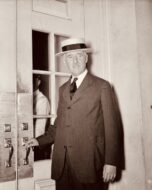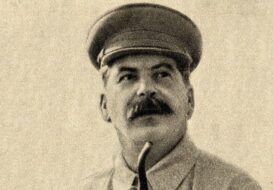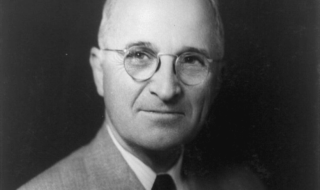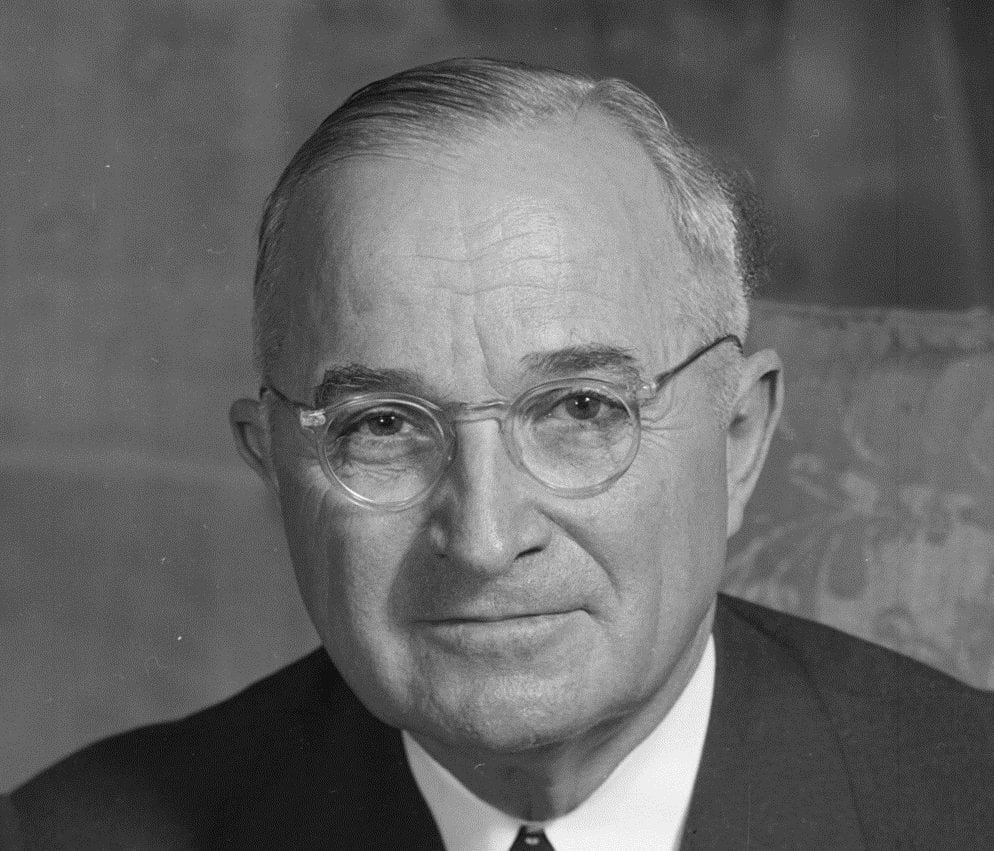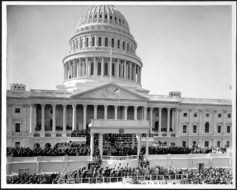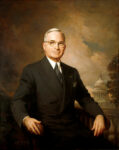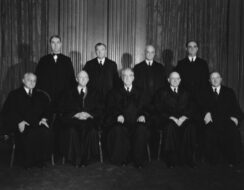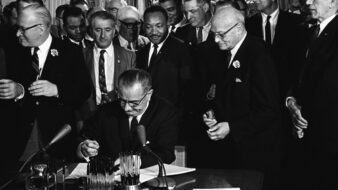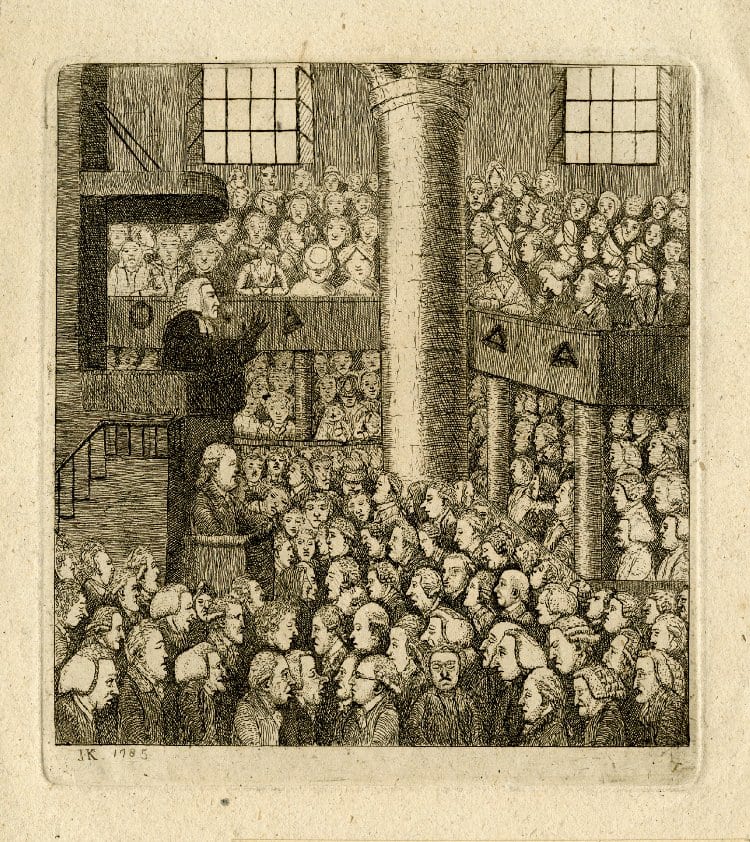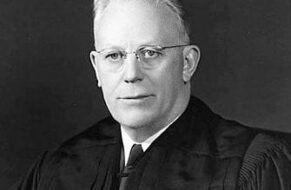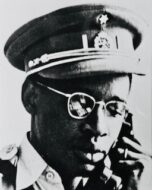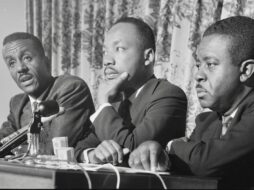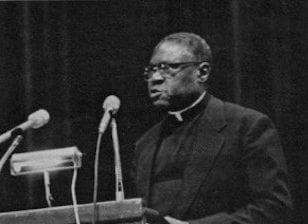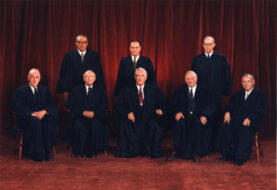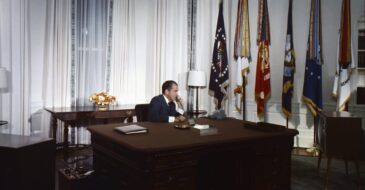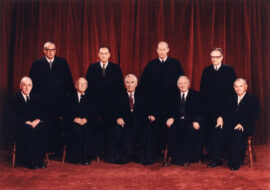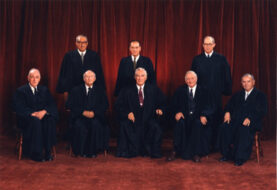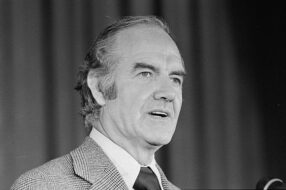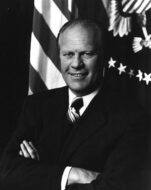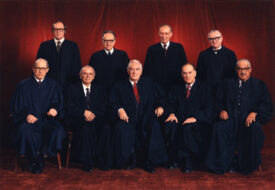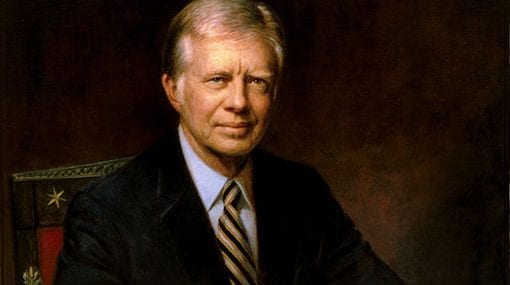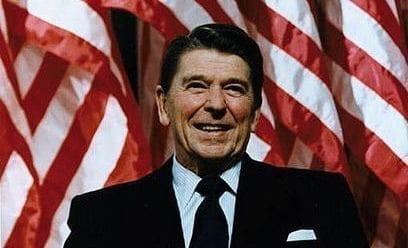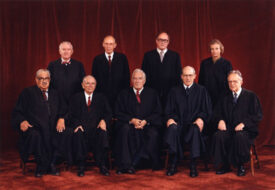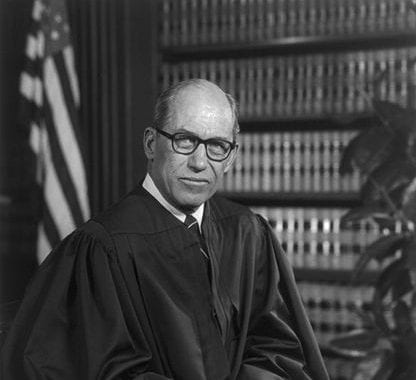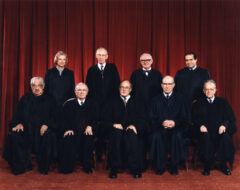

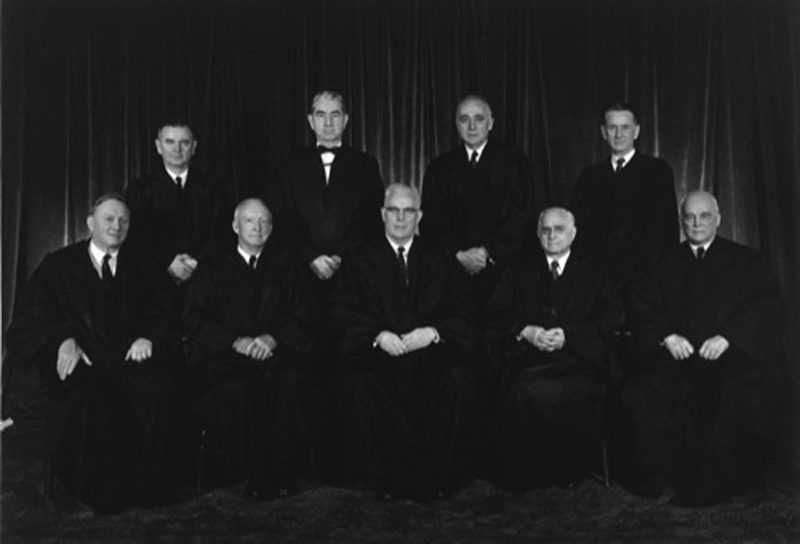
No related resources
Introduction
The First Amendment protects “freedom of speech,” but what is included in that protection? In Chaplinsky v. New Hampshire (1942), the Supreme Court reaffirmed that “[t]here are certain well-defined and narrowly limited classes of speech, the prevention and punishment of which has never been thought to raise any Constitutional problem. These include the lewd and obscene, the profane, the libelous, and the insulting or ‘fighting’ words.” . . .
In Roth v. US (1957), the Court grappled with what constitutes the “obscene” that is therefore unprotected by the First Amendment. This was an important decision because while it reaffirmed that obscenity is not protected under freedom of speech, it liberalized the judicial test for deciding what is obscene. This decision opened the door for more sexually explicit material to be sold, leading to many Supreme Court cases dealing with pornography over the next thirty years. In Miller v. California (1973), the Court refined Roth to a three-part test defining obscenity as material that, applying contemporary community standards, appeals to prurient interest, depicts sexual or excretory activities in a patently offensive manner, and is utterly without socially redeeming importance. Along with changing social mores, the difficulty of applying this test—especially in dealing with new technology like the internet—has led to a drastic reduction in the number of obscenity prosecutions across the country. More broadly, the doctrine of Roth has combined with the idea articulated in NY Times v. Sullivan (1964), that free speech “should be uninhibited, robust, and wide-open,” to lead the Supreme Court to hold that a much wider range of speech is now protected by the First Amendment.
Source: 354 U.S. 476; https://www.law.cornell.edu/supremecourt/text/354/476
Justice BRENNAN delivered the opinion of the Court, joined by Justices FRANKFURTER, BURTON, CLARK, and WHITAKER. Chief Justice WARREN concurred in the judgment.
. . . [T]he primary constitutional question is whether the federal obscenity statute violates the provision of the First Amendment that “Congress shall make no law . . . abridging the freedom of speech, or of the press. . . .”
Roth conducted a business in New York in the publication and sale of books, photographs and magazines. He used circulars and advertising matter to solicit sales. He was convicted by a jury in the District Court for the Southern District of New York upon 4 counts of a 26-count indictment charging him with mailing obscene circulars and advertising, and an obscene book, in violation of the federal obscenity statute. His conviction was affirmed by the Court of Appeals for the Second Circuit. We granted certiorari.[1]
The dispositive question is whether obscenity is utterance within the area of protected speech and press. Although this is the first time the question has been squarely presented to this Court, expressions found in numerous opinions indicate that this Court has always assumed that obscenity is not protected by the freedoms of speech and press.
The guaranties of freedom of expression in effect in 10 of the 14 States which by 1792 had ratified the Constitution, gave no absolute protection for every utterance. Thirteen of the 14 States provided for the prosecution of libel, and all of those States made either blasphemy or profanity, or both, statutory crimes. . . .
In light of this history, it is apparent that the unconditional phrasing of the First Amendment was not intended to protect every utterance. This phrasing did not prevent this Court from concluding that libelous utterances are not within the area of constitutionally protected speech. At the time of the adoption of the First Amendment, obscenity law was not as fully developed as libel law, but there is sufficiently contemporaneous evidence to show that obscenity, too, was outside the protection intended for speech and press.
The protection given speech and press was fashioned to assure unfettered interchange of ideas for the bringing about of political and social changes desired by the people. . . .
All ideas having even the slightest redeeming social importance—unorthodox ideas, controversial ideas, even ideas hateful to the prevailing climate of opinion—have the full protection of the guaranties, unless excludable because they encroach upon the limited area of more important interests. But implicit in the history of the First Amendment is the rejection of obscenity as utterly without redeeming social importance. This rejection for reason is mirrored in the universal judgment that obscenity should be restrained, reflected in the international agreement of over 50 nations, in the obscenity laws of all of the 48 States, and in the 20 obscenity laws enacted by the Congress from 1842 to 1956. This is the same judgment expressed by this Court in Chaplinsky v. New Hampshire (1942):
. . . There are certain well-defined and narrowly limited classes of speech, the prevention and punishment of which have never been thought to raise any Constitutional problem. These include the lewd and obscene. . . . It has been well observed that such utterances are no essential part of any exposition of ideas, and are of such slight social value as a step to truth that any benefit that may be derived from them is clearly outweighed by the social interest in order and morality.[2] . . .
We hold that obscenity is not within the area of constitutionally protected speech or press.
However, sex and obscenity are not synonymous. Obscene material is material which deals with sex in a manner appealing to prurient interest. The portrayal of sex, e. g., in art, literature and scientific works, is not itself sufficient reason to deny material the constitutional protection of freedom of speech and press. Sex, a great and mysterious motive force in human life, has indisputably been a subject of absorbing interest to mankind through the ages; it is one of the vital problems of human interest and public concern. . . .
The fundamental freedoms of speech and press have contributed greatly to the development and wellbeing of our free society and are indispensable to its continued growth. Ceaseless vigilance is the watchword to prevent their erosion by Congress or by the States. The door barring federal and state intrusion into this area cannot be left ajar; it must be kept tightly closed, and opened only the slightest crack necessary to prevent encroachment upon more important interests. It is therefore vital that the standards for judging obscenity safeguard the protection of freedom of speech and press for material which does not treat sex in a manner appealing to prurient interest.
The early leading standard of obscenity allowed material to be judged merely by the effect of an isolated excerpt upon particularly susceptible persons (Regina v. Hicklin [1868]) Some American courts adopted this standard, but later decisions have rejected it and substituted this test: whether, to the average person, applying contemporary community standards, the dominant theme of the material taken as a whole appeals to prurient interest. The Hicklin test, judging obscenity by the effect of isolated passages upon the most susceptible persons, might well encompass material legitimately treating with sex, and so it must be rejected as unconstitutionally restrictive of the freedoms of speech and press. On the other hand, the substituted standard provides safeguards adequate to withstand the charge of constitutional infirmity.
[The trial court] below sufficiently followed the proper standard. . . .
In summary, then, we hold that these statutes, applied according to the proper standard for judging obscenity, do not offend constitutional safeguards against convictions based upon protected material, or fail to give men in acting adequate notice of what is prohibited.
The [judgment is]
Affirmed.
Chief Justice WARREN, concurring in the result.
I agree with the result reached by the Court in these cases, but, because we are operating in a field of expression and because broad language used here may eventually be applied to the arts and sciences and freedom of communication generally, I would limit our decision to the facts before us and to the validity of the statutes in question as applied. . . .
. . . That there is a social problem presented by obscenity is attested by the expression of the legislatures of the forty-eight States as well as the Congress. To recognize the existence of a problem, however, does not require that we sustain any and all measures adopted to meet that problem. The history of the application of laws designed to suppress the obscene demonstrates convincingly that the power of government can be invoked under them against great art or literature, scientific treatises, or works exciting social controversy. Mistakes of the past prove that there is a strong countervailing interest to be considered in the freedoms guaranteed by the First and Fourteenth Amendments.
The line dividing the salacious or pornographic from literature or science is not straight and unwavering. Present laws depend largely upon the effect that the materials may have upon those who receive them. It is manifest that the same object may have a different impact, varying according to the part of the community it reached. But there is more to these cases. It is not the book that is on trial; it is a person. The conduct of the defendant is the central issue, not the obscenity of a book or picture. The nature of the materials is, of course, relevant as an attribute of the defendant's conduct, but the materials are thus placed in context from which they draw color and character. A wholly different result might be reached in a different setting. . . .
. . . [Roth was] plainly engaged in the commercial exploitation of the morbid and shameful craving for materials with prurient effect. I believe that the State and Federal Governments can constitutionally punish such conduct. That is all that these cases present to us, and that is all we need to decide. . . .
Justice HARLAN, dissenting.
. . . We are faced here with the question whether the federal obscenity statute, as construed and applied in this case, violates the First Amendment to the Constitution. To me, this question is of quite a different order than one where we are dealing with state legislation under the Fourteenth Amendment. . . .
The Constitution differentiates between those areas of human conduct subject to the regulation of the States and those subject to the powers of the Federal Government. . . .
The Federal Government has, for example, power to restrict seditious speech directed against it, because that Government certainly has the substantive authority to protect itself against revolution. But, in dealing with obscenity, we are faced with the converse situation, for the interests which obscenity statutes purportedly protect are primarily entrusted to the care not of the Federal Government, but of the States. Congress has no substantive power over sexual morality. Such powers as the Federal Government has in this field are but incidental to its other powers, here the postal power, and are not of the same nature as those possessed by the States, which bear direct responsibility for the protection of the local moral fabric. . . .
Not only is the federal interest in protecting the Nation against pornography attenuated, but the dangers of federal censorship in this field are far greater than anything the States may do. It has often been said that one of the great strengths of our federal system is that we have, in the forty-eight States, forty-eight experimental social laboratories. “State statutory law reflects predominantly this capacity of a legislature to introduce novel techniques of social control. The federal system has the immense advantage of providing forty-eight separate centers for such experimentation.”[3] Different States will have different attitudes toward the same work of literature. The same book which is freely read in one State might be classed as obscene in another. And it seems to me that no overwhelming danger to our freedom to experiment and to gratify our tastes in literature is likely to result from the suppression of a borderline book in one of the States so long as there is no uniform nation-wide suppression of the book, and so long as other States are free to experiment with the same or bolder books. . . .
I judge this case, then, in view of what I think is the attenuated federal interest in this field, in view of the very real danger of a deadening uniformity which can result from nationwide federal censorship, and in view of the fact that the constitutionality of this conviction must be weighed against the First, and not the Fourteenth, Amendment. So viewed, I do not think that this conviction can be upheld. . . .
Justice DOUGLAS dissenting, joined by Justice BLACK.
When we sustain [this conviction], we make the legality of a publication turn on the purity of thought which a book or tract instills in the mind of the reader. I do not think we can approve that standard and be faithful to the command of the First Amendment, which by its terms, is a restraint on Congress and which by the Fourteenth is a restraint on the States. . . .
Any test that turns on what is offensive to the community’s standards is too loose, too capricious, too destructive of freedom of expression to be squared with the First Amendment. Under that test, juries can censor, suppress, and punish what they don’t like, provided the matter relates to “sexual impurity” or has a tendency “to excite lustful thoughts.” This is community censorship in one of its worst forms. It creates a regime where, in the battle between the literati and the Philistines, the Philistines are certain to win. If experience in this field teaches anything, it is that “censorship of obscenity has almost always been both irrational and indiscriminate.”4 The test adopted here accentuates that trend.
I assume there is nothing in the Constitution which forbids Congress from using its power over the mails to proscribe conduct on the grounds of good morals. No one would suggest that the First Amendment permits nudity in public places, adultery, and other phases of sexual misconduct.
. . . [But w]hen speech alone is involved, I do not think that government, consistently with the First Amendment, can . . . throw its weight behind one school or another. Government should be concerned with antisocial conduct, not with utterances. Thus, if the First Amendment guarantee of freedom of speech and press is to mean anything in this field, it must allow protests even against the moral code that the standard of the day sets for the community. In other words, literature should not be suppressed merely because it offends the moral code of the censor. . . .
I do not think that the problem can be resolved by the Court’s statement that “obscenity is not expression protected by the First Amendment.” . . . Unlike the law of libel, . . . there is no special historical evidence that literature dealing with sex was intended to be treated in a special manner by those who drafted the First Amendment. In fact, the first reported court decision in this country involving obscene literature was in 1821. I reject too the implication that problems of freedom of speech and of the press are to be resolved by weighing against the values of free expression the judgment of the Court that a particular form of that expression has “no redeeming social importance.” The First Amendment, its prohibition in terms absolute, was designed to preclude courts as well as legislatures from weighing the values of speech against silence. The First Amendment puts free speech in the preferred position. . . .
- 1. A Latin word meaning “to be informed” or “we wish to be informed,” certiorari is an order of a higher court to review a lower court decision. “Certiorari” was the first word of such orders when they were written in Latin.
- 2. 315 U.S. 568, 571-572; https://www.law.cornell.edu/supremecourt/text/315/568. Emphasis in original.
- 3. Harry M. Hart, Jr., “The Relations Between State and Federal Law,” Columbia Law Review 54, no. 4 (April 1954): 493.
- 4. William B. Lockhart & Robert C. McClure, "Literature, The Law of Obscenity, and the Constitution," Minnesota Law Review 38, 4(March 1954), 295, 387.

Conversation-based seminars for collegial PD, one-day and multi-day seminars, graduate credit seminars (MA degree), online and in-person.

